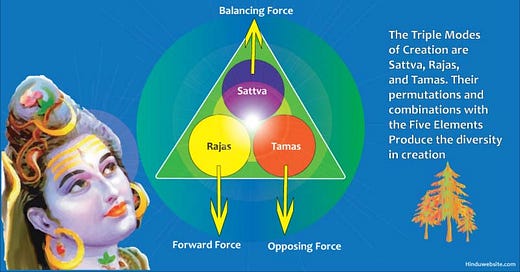Sattvic Organic Foods
We looked at Ayurveda as being a whole and complete way of living through yoga, through breathing, meditation and through the eight limbs of Yoga. Now we will look at how Ayurveda looks at our food since the food we eat is the fuel that nourishes our bodies to keep us healthy.
In Ayurveda, food into divided into three different categories based on the energy that the food (fuel) generates or does not generate and how it affects the mind and the body. These three categories are know as Sattva, Rajas and Tamas. These are the three gunas (forces or interwoven “strands”) that we need to be aware of and balance in our diets. We will discuss each category separately so we understand how they affect us.
According to Ayurveda, Sattva is a Sanskrit word meaning “light”, or “goodness” and “purity”. When we think of Sattva, the image that comes to mind is that of a clear glass window where light shines through. Sattva properties can be expressed as intelligence, awareness, virtue, and joy. It also embodies traits such as honesty, integrity, goodness, virtue, purity, cleanliness, simplicity, enlightenment, knowledge, serenity, balance, selflessness and devotion.
Spiritually, like the glass window, we can think of Sattva as a pure, enlightened being, free from all attachments, ego, and worldly desires. In Ayurveda, this is the highest and most desirable state as it is brings inner peace, happiness and spiritual growth to those who attain it. When Sattva energy flows, we are aligned with peaceful behaviour which allows us to develop relationships with all beings based on unconditional love and respect.
So foods that are Sattvic fuel the body creating purity, health, harmony and well being when eaten. These plant based foods are organically sourced and grown. They include fruits and vegetables brought in directly from the garden or farm which are eaten as soon as they are harvested to maximise their life giving energy (prana). Sattvic foods include most organic fruits and vegetables (leafy greens, carrots, and broccoli, etc.), grains such basmati rice, animal products such as ghee (clarified butter) as well as unpasteurized raw honey. Herbs, such as Tulsi or holy Basil (Ocimum tenuiflorum) are considered to be one of the most important herbs in Ayurveda. Other herbs include Amalaki (amla or Indian gooseberry - phyllanthus emblica), Ashwagandha (Indian ginseng - withania somnifera), Shatavari (asparagus racemosus), lotus seeds (nelumbo nucifera) and goji berry (wolfberry - lycium barbarum) .

These foods and herbs contain a strong life force which strengthens our own life force. They are easy to digest, promote health, wellness and mental clarity. They nourish and uplift both our mind and body. Since they have a strong life force, they also have the highest nutritional values which benefit our body. We can call them “superfoods” as when we eat them, we feel light, healthy and energized.
Sattvic foods are highly prized in Ayurveda based on their qualities above. They soothe our body, nourish us deeply, help quieten our mind and increase our intellect. They are predominantly vegetarian and rarely include animal foods other than ghee. When animal foods are used, it is essential to ensure that they come from animals that have been treated with love, kindness, respect and proper environments to keep them healthy and happy throughout their lifetime and beyond. Sattvic foods are organic and do not contain preservatives, artificial flavors, genetically modified foods or additives.
When one follows a sattvic diet, according to Ayurveda, we eat foods that have a high frequency or energy. This helps our mind understand deeper spiritual truths which brings contentment. (A food’s frequency is created from the way it is organically grown and cultivated (with love and mindfulness), its freshness, how it is prepared and how it is enjoyed).
Since food is energy and fuel, it is essential in a sattvic diet that the energy in our kitchen comes from a calm and pleasant atmosphere when preparing the food. Foods are cooked lightly with loving intention in a peaceful kitchen, prepared mindfully and served in a harmonious environment. They are also eaten slowly while enjoying every mouthful.
In this respect, it is highly recommended to avoid cooking when angry or upset or while experiencing negative emotions as this energy will end up in the meal being prepared. Low-frequency foods such as genetically modified foods, canned, frozen, fried, or ready made meals are mostly avoided in Sattvic diets. One may recall, a meal cooked with family and friends with laughter and harmony will always taste better and digest easier. Yet foods cooked where there is anger or arguments often ends up causing digestive issues.
When we prepare our food with mindfulness, care and love, this creates positive energetic vibrations that are absorbed by the food that is being prepared. The quality of our food is greatly enhanced by our loving attention to the way we cut our vegetables, grind our fresh spices, the way we add ingredients into the cooking pot and the way it is served. Laughter and conversation enhance the benefits of the food we eat as this energy enters our body during digestion and affects our own energy.
People on Sattvic diets tend to be cheerful, gentle, pleasant and friendly. They radiate happiness and positive energy.
This gives you a quick overview of Sattvic foods. We will discuss the next two food categories called Rajvic and Tamasic in the next few articles. When we understand and accept that the foods we eat have energetic properties and affect both our body’s energy and our mental health, we begin to make educated choices as to what we put into our mouths.
***********************************************************************************************************






